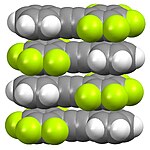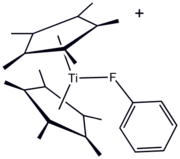Sometimes, the gamma decay
from a metastable state is referred to as isomeric transition, but this
process typically resembles shorter-lived gamma decays in all external
aspects with the exception of the long-lived nature of the meta-stable
parent nuclear isomer. The longer lives of nuclear isomers' metastable
states are often due to the larger degree of nuclear spin change which
must be involved in their gamma emission to reach the ground state. This
high spin change causes these decays to be forbidden transitions and delayed. Delays in emission are caused by low or high available decay energy.
The first nuclear isomer and decay-daughter system (uranium X2/uranium Z, now known as 234m
91Pa
/234
91Pa
) was discovered by Otto Hahn in 1921.
The first nuclear isomer and decay-daughter system (uranium X2/uranium Z, now known as 234m
91Pa
/234
91Pa
) was discovered by Otto Hahn in 1921.
Nuclei of nuclear isomers
The nucleus of a nuclear isomer occupies a higher energy state than the non-excited nucleus existing at ground state. In an excited state, one or more of the protons or neutrons in a nucleus occupy a nuclear orbital of higher energy than an available nuclear orbital. These states are analogous to excited states of electrons in atoms.
When excited atomic states decay, energy is released by fluorescence. In electronic transitions, this process usually involves emission of light near the visible range. The amount of energy released is related to bond-dissociation energy or ionization energy and is usually in the range of a few to few tens of eV per bond.
However, a much stronger type of binding energy, the nuclear binding energy, is involved in nuclear processes. Due to this, most nuclear excited states decay by gamma ray emission. For example, a well-known nuclear isomer used in various medical procedures is 99m
43Tc
which decays with a half-life of about 6 hours by emitting a gamma ray of 140 keV of energy; this is close to the energy of medical diagnostic X-rays.
43Tc
which decays with a half-life of about 6 hours by emitting a gamma ray of 140 keV of energy; this is close to the energy of medical diagnostic X-rays.
Nuclear isomers have long half lives because their gamma decay is
"forbidden" from the large change in nuclear spin needed to emit a
gamma ray. For example, 180m
73Ta
has a spin of 9 and must gamma decay to 180
73Ta
with a spin of 1. Similarly, 99m
43Tc
has a spin of 1/2 and must gamma decay to 99
43Tc
with a spin of 9/2.
73Ta
has a spin of 9 and must gamma decay to 180
73Ta
with a spin of 1. Similarly, 99m
43Tc
has a spin of 1/2 and must gamma decay to 99
43Tc
with a spin of 9/2.
While most metastable isomers decay through gamma ray emission, they can also decay through internal conversion.
During internal conversion, energy of nuclear de-excitation is not
emitted as a gamma ray but is instead used to accelerate one of the
inner electrons of the atom. These excited electrons then leave at a
high speed. This occurs because inner atomic electrons penetrate the
nucleus where they are subject to the intense electric fields created
when the protons of the nucleus re-arrange in a different way.
In nuclei which are far from stability in energy even more decay modes are known.
Metastable isomers
Metastable isomers can be produced through nuclear fusion or other nuclear reactions.
A nucleus produced this way generally starts its existence in an
excited state that relaxes through the emission of one or more gamma rays or conversion electrons. Sometimes the de-excitation does not completely proceed rapidly to the nuclear ground state. This usually occurs when the formation of an intermediate excited state has a spin
far different from that of the ground state. Gamma-ray emission is
hindered if the spin of the post-emission state varies greatly from that
of the emitting state especially if the excitation energy is low. The
excited state in this situation is a good candidate to be metastable if
there are no other states of intermediate spin with excitation energies
less than that of the metastable state.
Metastable isomers of a particular isotope
are usually designated with an "m". This designation is placed after
the mass number of the atom; for example, cobalt-58m is abbreviated 58m
27Co
, where 27 is the atomic number of cobalt. For isotopes with more than one metastable isomer, "indices" are placed after the designation, and the labeling becomes m1, m2, m3, and so on. Increasing indices, m1, m2, etc., correlate with increasing levels of excitation energy stored in each of the isomeric states (e.g., hafnium-178m2 or 178m2
72Hf
).
27Co
, where 27 is the atomic number of cobalt. For isotopes with more than one metastable isomer, "indices" are placed after the designation, and the labeling becomes m1, m2, m3, and so on. Increasing indices, m1, m2, etc., correlate with increasing levels of excitation energy stored in each of the isomeric states (e.g., hafnium-178m2 or 178m2
72Hf
).
A different kind of metastable nuclear state (isomer) is the fission isomer or shape isomer. Most actinide nuclei in their ground states are not spherical, but rather prolate spheroidal, with an axis of symmetry
longer than the other axes similar to an American football or rugby
ball. This geometry can result in quantum-mechanical states where the
distribution of protons and neutrons is so much further from spherical
geometry that de-excitation to the nuclear ground state is strongly
hindered. In general, these states either de-excite to the ground state
far more slowly than a "usual" excited state, or they undergo spontaneous fission with half-lives of the order of nanoseconds or microseconds—a
very short time, but many orders of magnitude longer than the half-life
of a more-usual nuclear excited state. Fission isomers are usually
denoted with a postscript or superscript "f" rather than "m", so that a
fission isomer, e.g. of plutonium-240, is denoted plutonium-240f or 240f
94Pu
.
94Pu
.
Nearly-stable isomers
Most nuclear excited states are very unstable and "immediately" radiate away the extra energy after existing on the order of 10−12 seconds. As a result, the characterization "nuclear isomer" is usually applied only to configurations with half-lives of 10−9 seconds or longer. Quantum mechanics
predicts that certain atomic species will possess isomers with
unusually long lifetimes even by this stricter standard and have
interesting properties. Some nuclear isomers are so long-lived that they
are relatively stable and can be produced and observed in quantity.
The most stable nuclear isomer occurring in nature is 180m
73Ta
which is present in all tantalum samples at about 1 part in 8,300. Its half-life is at least 1015 years, markedly longer than the age of the universe. The low excitation energy of the isomeric state causes both gamma de-excitation to the 180Ta
ground state (which itself is radioactive by beta decay, with a half-life of only 8 hours) and direct beta decay to hafnium or tungsten to be suppressed due to spin mismatches. The origin of this isomer is mysterious, though it is believed to have been formed in supernovae (as are most other heavy elements). Were it to relax to its ground state, it would release a photon with a photon energy of 75 keV.
73Ta
which is present in all tantalum samples at about 1 part in 8,300. Its half-life is at least 1015 years, markedly longer than the age of the universe. The low excitation energy of the isomeric state causes both gamma de-excitation to the 180Ta
ground state (which itself is radioactive by beta decay, with a half-life of only 8 hours) and direct beta decay to hafnium or tungsten to be suppressed due to spin mismatches. The origin of this isomer is mysterious, though it is believed to have been formed in supernovae (as are most other heavy elements). Were it to relax to its ground state, it would release a photon with a photon energy of 75 keV.
It was first reported in 1988 by Collins that 180mTa
can be forced to release its energy by weaker X-rays. This way of de-excitation had never been observed; however, the de-excitation of 180mTa
via resonant photo-excitation of intermediate high levels of this nucleus (E~1 MeV) was found in 1999 by Belic and co-workers in the Stuttgart nuclear physics group.
can be forced to release its energy by weaker X-rays. This way of de-excitation had never been observed; however, the de-excitation of 180mTa
via resonant photo-excitation of intermediate high levels of this nucleus (E~1 MeV) was found in 1999 by Belic and co-workers in the Stuttgart nuclear physics group.
178m2
72Hf
is another reasonably stable nuclear isomer which possesses a half-life of 31 years and the highest excitation energy of any comparably long-lived isomer. One gram of pure 178m2Hf
contains approximately 1.33 gigajoules of energy, the equivalent of exploding about 315 kg (694 lb) of TNT. In the natural decay of 178m2Hf
, the energy is released as gamma rays with a total energy of 2.45 MeV. As with 180mTa
, there are disputed reports that 178m2Hf
can be stimulated into releasing its energy. Due to this, the substance is being studied as a possible source for gamma ray lasers. These reports indicate that the energy is released very quickly, so that 178m2Hf
can produce extremely high powers (on the order of exawatts). Other isomers have also been investigated as possible media for gamma-ray stimulated emission.
72Hf
is another reasonably stable nuclear isomer which possesses a half-life of 31 years and the highest excitation energy of any comparably long-lived isomer. One gram of pure 178m2Hf
contains approximately 1.33 gigajoules of energy, the equivalent of exploding about 315 kg (694 lb) of TNT. In the natural decay of 178m2Hf
, the energy is released as gamma rays with a total energy of 2.45 MeV. As with 180mTa
, there are disputed reports that 178m2Hf
can be stimulated into releasing its energy. Due to this, the substance is being studied as a possible source for gamma ray lasers. These reports indicate that the energy is released very quickly, so that 178m2Hf
can produce extremely high powers (on the order of exawatts). Other isomers have also been investigated as possible media for gamma-ray stimulated emission.
Holmium's nuclear isomer, 166m1
67Ho
has a half-life of 1,200 years, which is nearly the longest half-life of any holmium radionuclide. Only 163Ho
, with a half-life of 4,570 years, is longer.
67Ho
has a half-life of 1,200 years, which is nearly the longest half-life of any holmium radionuclide. Only 163Ho
, with a half-life of 4,570 years, is longer.
229
90Th
has a remarkably low-lying metastable isomer, estimated at only 7.8±0.5 eV above the ground state. After years of failure and one notable false alarm, this decay was directly observed in 2016, producing a gamma ray (defined by its origin, not its wavelength) in the ultraviolet range. The observed energy was between 6.3 and 18.3 eV (200–70 nm). The range is broad because the experiment was optimized for detection rather than precision measurement.
90Th
has a remarkably low-lying metastable isomer, estimated at only 7.8±0.5 eV above the ground state. After years of failure and one notable false alarm, this decay was directly observed in 2016, producing a gamma ray (defined by its origin, not its wavelength) in the ultraviolet range. The observed energy was between 6.3 and 18.3 eV (200–70 nm). The range is broad because the experiment was optimized for detection rather than precision measurement.
High spin suppression of decay
The
most common mechanism for suppression of gamma decay of excited nuclei,
and thus the existence of a metastable isomer, is lack of a decay route
for the excited state that will change nuclear angular momentum along
any given direction by the most common amount of 1 quantum unit ħ in the spin
angular momentum. This change is necessary to emit a gamma photon which
has a spin of 1 unit in this system. Integral changes of 2, 3, 4, and
more units in angular momentum are possible, but the emitted photons
carry off the additional angular momentum. Changes of more than 1 unit
are known as forbidden transitions. Each additional unit of spin change
larger than 1 that the emitted gamma ray must carry inhibits decay rate
by about 5 orders of magnitude. The highest known spin change of 8 units occurs in the decay of 180mTa, which suppresses its decay by a factor of 1035 from that associated with 1 unit. Instead of a natural gamma decay half life of 10−12 seconds, it has a half life of more than 1023 seconds, or at least 3 × 1015 years, and thus has yet to be observed to decay.
Gamma emission is impossible when the nucleus begins in a
zero-spin state, as such an emission would not conserve angular
momentum.
Applications
Hafnium and tantalum isomers have been considered in some quarters as weapons that could be used to circumvent the Nuclear Non-Proliferation Treaty, since it is claimed they can be induced to emit very strong gamma radiation. This claim is generally discounted. DARPA has (or had) a program to investigate this use of both nuclear isomers.
The potential to trigger an abrupt release of energy from nuclear
isotopes, a prerequisite to their use in such weapons, is disputed.
Nonetheless a 12-member Hafnium Isomer Production Panel (HIPP) was
created to assess means of mass-producing the isotope.
Technetium isomers 99m
43Tc
(with a half-life of 6.01 hours) and 95m
43Tc
(with a half-life of 61 days) are used in medical and industrial applications.
43Tc
(with a half-life of 6.01 hours) and 95m
43Tc
(with a half-life of 61 days) are used in medical and industrial applications.
Nuclear batteries
Nuclear decay pathways for the conversion of lutetium-177m to hafnium-177
Nuclear batteries use small amounts (milligrams and microcuries)
of radioisotopes with high energy densities. In one design, radioactive
material sits atop a device with adjacent layers of P-type and N-type
silicon. Ionizing radiation directly penetrates the junction and creates
electron-hole pairs. Nuclear isomers could replace other isotopes, and
with further development, it may be possible to turn them on and off by
triggering decay as needed. Current candidates for such use include 108Ag, 166Ho, 177Lu, and 241Am. As of 2004 the only isomer which had been successfully triggered was 180mTa which required more photon energy to trigger than was released.
An isotope such as 177Lu releases gamma rays by decay
through a series of internal energy levels within the nucleus, and it is
thought that by learning the triggering cross sections with sufficient
accuracy, it may be possible to create energy stores that are 106 times more concentrated than high explosive or other traditional chemical energy storage.
Decay processes
An isomeric transition (IT) is the decay of a nuclear isomer to a lower-energy nuclear state. This radioactive decay process involves emission of a gamma ray. The actual process can have two effects:
- γ (gamma) emission (emission of a high-energy photon)
- internal conversion (the energy is used to excite the atom's electrons)
Isomers may decay into other elements, though the rate of decay may differ between isomers. For example, 177mLu can beta decay to 177Hf with a half-life of 160.4 d, or it can undergo isomeric transition to 177Lu with a half-life of 160.4 d which then beta decays to 177Hf with a half-life of 6.68 d.
The emission of a gamma ray from an excited nuclear state allows
the nucleus to lose energy and reach a lower energy state, sometimes its
ground state. In certain cases, the excited nuclear state following a nuclear reaction or other type of radioactive decay can become a metastable
nuclear excited state. Some nuclei are able to stay in this metastable
excited state for minutes, hours, days, or occasionally far longer,
before undergoing gamma decay, in which they emit a gamma ray.
The process of isomeric transition is similar to any gamma
emission from any excited nuclear state, but differs by involving
excited metastable states of nuclei with longer half lives. These states
are created, as all nuclei that undergo gamma radioactive decay, following the emission of an alpha particle, beta particle, or occasionally other types of particles that leave the nucleus in an excited state.
The gamma ray may transfer its energy directly to one of the most tightly bound electrons causing that electron to be ejected from the atom, a process termed the photoelectric effect. This should not be confused with the internal conversion process, in which no gamma ray photon is produced as an intermediate particle.










